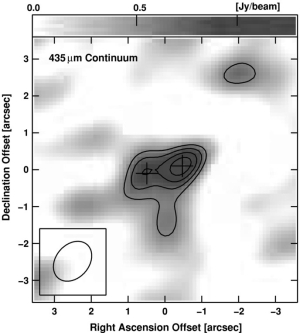 |
|
|
| SMA Research: Extragalactic | ||||
|
Astronomers have long suspected that some of the most luminous starburst galaxies in the high-redshift universe, which are forming stars hundred or thousands of times more vigorously than our Milky Way, are almost completely hidden at visible wavelengths by the effects of dust. Over the past decade, the first surveys at millimeter and submillimeter wavelengths have uncovered a large and cosmologically important population of these objects. So-called submillimeter galaxies likely represent systems in transition from gas-rich spiral galaxies to massive 'red and dead' ellipticals by way of collisions between galaxies that drive a powerful nuclear starburst.
Nearby galaxies supply us with the opportunity to study galaxy dynamics and star formation on large scales, yet are close enough to reveal the details needed to make connections to the phenomena we observe around us in the Milky Way. Nearby galaxy studies therefore provide a better understanding of the physical properties of our own Galaxy, in which observations are often hampered by high obscuration from dust and by our location inside its disk. Additionally, studying a diverse sample of nearby galaxies allows us to determine the evolution of galaxies with time, and to better constrain the conditions and evolution of high redshift galaxies that we currently cannot resolve.
The SMA has unique capabilities to examine each of these classes of galaxies, and provides information not available through other observational means.
|

The 435µm (689 GHz) continuum emission image of the central region of Arp 220. The synthesized beam (1.2" x 0.9", or 470 pc x 350 pc) with the P.A. of 139° is shown at the bottom left corner. The two crosses indicate the 1.3mm continuum peaks (Downes & Soloman 1998, Sakamoto et al. 1999), which correspond to the double nucleus. The contour levels are 3,4,5 and 6σ, where 1σ = 190 mJy beam-1. The position offsets are measured from α(2000) = 15h34m57.25s and δ(2000) = 23°30'11.4". (Matsushita et al. 2009) | |||
|
|
